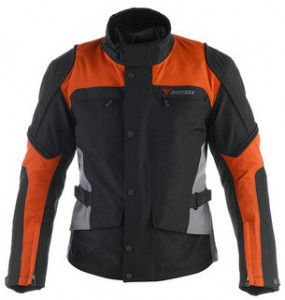10 Functions to Look for in Motorcycle Jackets
by Liz Jansen
Motorcycle jackets are one of the first pieces of gear a new rider or passenger wears. Function, fit and fashion are now integrated in a plethora of styles and materials.
Whether you select leather or textile, consider these features.
- Fit. Try on the jacket, and then assume the seating position you’re in on your bike. Reach forward as you would while holding the grips and make sure the sleeves are long enough to cover your wrists. Look for adjustable waists to fit different sizes and accommodate layers. Jackets need to be long enough to cover your lower back while riding. To ensure maximum protection in the event of a slide on the road, the jacket should fit your body snugly.
- Arm length. Sleeves should look slightly long when standing. Like pants, they’re designed to protect you when your arms are stretched in the riding position, not when you’re walking around off the bike. You want the gauntlet of your glove to cover the end of your sleeve.
- Abrasion resistance. Even a minor tumble can have you sliding down the pavement,. Leather and textiles each offer a high degree of protection. Read the label to find out how much.
- Armor. The best jackets have padding at elbows, shoulders and back. A proper fit means padding will actually fall below your elbows when your arms are hanging straight but cover your elbows while flexed in your riding position. Look for armor that can be removed for cleaning. All armor is not created equal. Buy the highest quality you can afford.
- Ventilation. On hot days, good ventilation is a lifesaver. At minimum, look for vents on the chest and back for flow-through ventilation. It’s also nice to have underarm vents. Big zipper pulls make vents easier to open and close with gloves while riding.
- Pockets. On a jacket, you want both interior and exterior pockets. Preferably waterproof with good seals on exterior pockets.
- Construction. Riding jackets have a variety of fasteners from zippers to Velcro to snaps. Make sure they’re high quality and that the jackets themselves have been well assembled. Inspect seams, lining and closures for finishing details. Choose adjustable closures at wrists and neck. Although Velcro works anywhere else, stay away from it at your neck. It’s hell on helmet straps.
- Versatility. Zip-in linings extend the utility of your jacket. Most jackets with liners will take you through 3 seasons. Make sure your jacket has enough room for those extra layers you may wear in cooler weather.
- Visibility. Whether it’s piping or inserts, your upper body plays a role in making you conspicuous to others on the road. The reflective surfaces picked up by headlights may be the difference between alerting a car driver to your presence and getting hit. You may want to go all the way to a high-viz color or do as I do and wear a reflective vest. That allows a little more choice in style preferences.
- Water resistance. Ideally water proof. Finding breathable, waterproof jackets at an affordable price is a challenge. Although not as impractical as rain liners in pants, my first choice is to shun a waterproof liner in favor of a separate rain jacket. While pricier, the superior overall functionality of GORE-TEX® can’t be beat.
Take your time, ask lots of questions, try on the gear and sit on a bike in a position similar to the one you use. Determine which features are important to you. When a salesperson is trying to close the deal, think through the logic of the features to your own application. You’re making a decision about your safety so choose wisely.
photo credit: GORE-TEX® Products via photopin cc


Great list! Number 10 is the key for me! The idea of undressing (and removing boots!) on the side of the road to install waterproof liners makes absolutely NO sense to me.
In our climate, we have to have mesh summer gear (90+ degree F) and waterproof winter gear (20s F). No 3 season gear can do the trick across our temperature range. Mesh and rain gear in the summer do the trick and it is much easier to put rain gear OVER the mesh on the side of the road than vice versa!
It gets complicated doesn’t it?
I like to wear gear that’s as versatile as possible. The least pieces of gear for the most coverage – and still be comfortable!
Safe travels. Looks like my season is about done for this year.